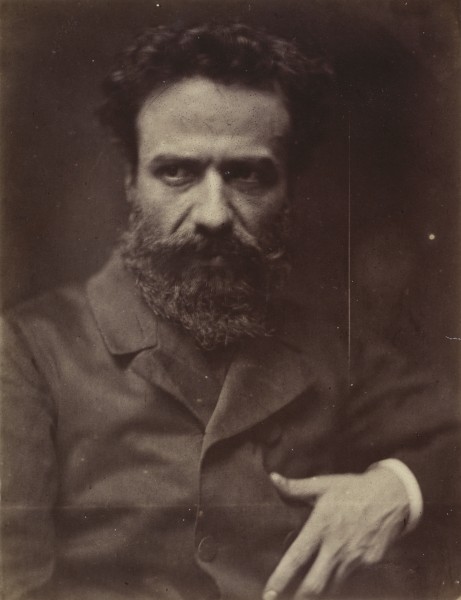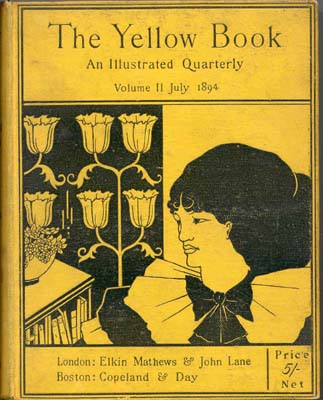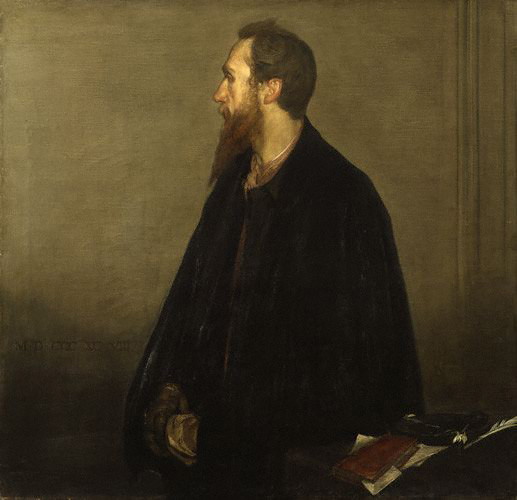 William Rothenstein was born into a German-Jewish family at
William Rothenstein was born into a German-Jewish family at 4 spring bank Bradford, West Yorkshire.(above Mary remington nude student of william)
4 spring bank Bradford, West Yorkshire.(above Mary remington nude student of william) His father, Moritz, emigrated from Germany in 1859 to work in Bradford's burgeoning textile
His father, Moritz, emigrated from Germany in 1859 to work in Bradford's burgeoning textile  industry. Soon afterwards he married Bertha Dux and they had six children, of which William was the fifth.
industry. Soon afterwards he married Bertha Dux and they had six children, of which William was the fifth.Rothenstein left Bradford Grammar School
 at the age of sixteen to study at the
at the age of sixteen to study at the Two Women', Sir William Rothenstein - Tate collection [Painting, 1890-9, objects, clothing and personal effects, dress, hat, bonnet, people, act... Slade School of Art, London (1888–1893), where he was taught by Alphonse Legros,
Two Women', Sir William Rothenstein - Tate collection [Painting, 1890-9, objects, clothing and personal effects, dress, hat, bonnet, people, act... Slade School of Art, London (1888–1893), where he was taught by Alphonse Legros, and the Académie Julian in Paris (1889–1893),
and the Académie Julian in Paris (1889–1893), where he met and was encouraged by James McNeill Whistler, Edgar Degas and Henri Toulouse-Lautrec.
where he met and was encouraged by James McNeill Whistler, Edgar Degas and Henri Toulouse-Lautrec.Whilst in Paris he also befriended the Anglo-Australian artist Charles Conder, with whom he shared a studio in Montmartre. His biographer, Mary Lago, has pointed out: "He became known as a person with a gift for friendship and as a precocious talent."
 jan toorop
jan tooropMax Beerbohm commented: "He was a wit. He was brimful of ideas. He knew Whistler. He knew Edmond de Goncourt. He knew everyone in Paris. He knew them all by heart. He was Paris in Oxford." As a result of his contacts, Rothenstein was commissioned to produce
 Oxford Characters (1896) and English Portraits
Oxford Characters (1896) and English Portraits (1898). In 1893 he returned to England to work on "Oxford Characters" a series of lithographic portraits.
(1898). In 1893 he returned to England to work on "Oxford Characters" a series of lithographic portraits.In Oxford he met and became a close friend of the caricaturist and parodist Max Beerbohm, who later immortalised him in the short story Enoch Soames
 (1919). During the 1890s Rothenstein exhibited with the New English Art Club
(1919). During the 1890s Rothenstein exhibited with the New English Art Club  and contributed drawings to The Yellow Book
and contributed drawings to The Yellow Book and The Savoy (periodical)
and The Savoy (periodical) . In 1900 he won a silver medal for his painting The Doll's House at the Exposition Universelle.
. In 1900 he won a silver medal for his painting The Doll's House at the Exposition Universelle. In 1898 he co-founded the Carfax Gallery in St. James' Piccadilly with John Fothergill (later innkeeper of the Spread Eagle in Thame). During its early years the gallery was closely associated with such artists as Charles Conder, Philip Wilson Steer
In 1898 he co-founded the Carfax Gallery in St. James' Piccadilly with John Fothergill (later innkeeper of the Spread Eagle in Thame). During its early years the gallery was closely associated with such artists as Charles Conder, Philip Wilson Steer , Charles Ricketts
, Charles Ricketts and Augustus John
and Augustus John . It also exhibited the work of Auguste Rodin, whose growing reputation in England owed much to Rothenstein's friendship and missionary zeal. The gallery was later the home for all three exhibitions of The Camden Town Group, led by Rothenstein's friend and close contemporary Walter Sickert
. It also exhibited the work of Auguste Rodin, whose growing reputation in England owed much to Rothenstein's friendship and missionary zeal. The gallery was later the home for all three exhibitions of The Camden Town Group, led by Rothenstein's friend and close contemporary Walter Sickert.In 1907 Rothenstein gave important support to Jacob Epstein. Rothenstein also took a keen interest in the career of Mark Gertler. After seeing the work of the sixteen-year-old East Ender in 1908 he wrote to his father: "It is never easy to prophesy regarding the future of an artist but I do sincerely believe that your son has gifts of a high order, and that if he will cultivate them with love and care, that you will one day have reason to be proud of him. I believe that a good artist is a very noble man, and it is worth while giving up many things which men consider very important, for others which we think still more so. From the little I could see of the character of your son, I have faith in him and I hope and believe he will make the best possible use of the opportunities I gather you are going to be generous enough to give him." Rothenstein managed to secure a place at the Slade School of Fine Art and arranged for his fees to be paid by the Jewish Educational Aid Societ
Rothenstein is best known for his portrait drawings of famous individuals and for being an official war artist in both World War I and World War II. He was also a member of the International Society of Sculptors, Painters & Gravers. The style and subject of his paintings varies, though certain themes reappear, in particular an interest in 'weighty' or 'essential' subjects tackled in a restrained manner. Good examples include Parting at Morning (1891).
On the outbreak of First World War in 1914 the Rothenstein family suffered from strong anti-German feeling in Britain. The three brothers decided to change the family name to Rutherston. Charles and Albert went through with the change but at the last minute William decided that it "meant too great a sacrifice of continuity and identity" and remained as Rothenstein.
Only two photographers, both army officers, were allowed to take pictures of the Western Front. The penalty for anyone else caught taking a photograph of the war was the firing squad. Charles
 Masterman, head of the War Propaganda Bureau (WPB), was aware that the right sort of pictures would help the war effort. In May 1916 Masterman recruited the artist, Muirhead Bone.
Masterman, head of the War Propaganda Bureau (WPB), was aware that the right sort of pictures would help the war effort. In May 1916 Masterman recruited the artist, Muirhead Bone.Soon after he arrived on the Somme front he was arrested as a spy. He stayed with the British Fifth Army in 1918 and during the German Spring Offensive, served as a unofficial medical orderly. He returned to England in March and his pictures were exhibited in May, 1918. Pictures by Rothenstein included The Ypres Salient
 and Talbot House, Ypres.
and Talbot House, Ypres.
 He was sent to France and by October had produced 150 drawings of the war. When Bone returned to England he was replaced by his brother-in-law, Francis Dodd
He was sent to France and by October had produced 150 drawings of the war. When Bone returned to England he was replaced by his brother-in-law, Francis Dodd , who had been working for the Manchester Guardian.
, who had been working for the Manchester Guardian.  ,parting at morning
,parting at morningMother and Child (1903)
 and Jews Mourning at a Synagogue (1907) -
and Jews Mourning at a Synagogue (1907) - all of which are owned by the Tate Gallery. The National Portrait Gallery owns over two hundred of his portraits. In 2011 the BBC and the Public Catalogue Foundation began cataloguing all of his paintings in public ownership online.[5]
all of which are owned by the Tate Gallery. The National Portrait Gallery owns over two hundred of his portraits. In 2011 the BBC and the Public Catalogue Foundation began cataloguing all of his paintings in public ownership online.[5]Between 1902 and 1912 Rothenstein lived in Hampstead,
 London, where his social circle included such names as H. G. Wells, Joseph Conrad and the artist Augustus John. Amongst the young artists to visit Rothenstein in Hampstead were Wyndham Lewis, Mark Gertler and Paul Nash. During this period Rothenstein worked on a series of important paintings in the predominantly Jewish East End of London., some of which were included in the influential 1906 exhibition of Jewish Art and Antiquaries at the Whitechapel Gallery.
London, where his social circle included such names as H. G. Wells, Joseph Conrad and the artist Augustus John. Amongst the young artists to visit Rothenstein in Hampstead were Wyndham Lewis, Mark Gertler and Paul Nash. During this period Rothenstein worked on a series of important paintings in the predominantly Jewish East End of London., some of which were included in the influential 1906 exhibition of Jewish Art and Antiquaries at the Whitechapel Gallery. [2] Despite this, Rothenstein is rarely considered as a major Anglo-Jewish artist.
[2] Despite this, Rothenstein is rarely considered as a major Anglo-Jewish artist.Another feature of this period are the celebrated interiors he painted, the most famous of which is The Browning Readers (1900),
 now owned by Cartwright Hall Gallery, Bradford. Most of Rothenstein's interiors feature members of his family, especially his wife Alice (née Knewstub) whom he married in 1899. Reminiscent of Dutch painting (particularly Vermeer and Rembrandt), they are are similar in style to contemporary works by William Orpen,
now owned by Cartwright Hall Gallery, Bradford. Most of Rothenstein's interiors feature members of his family, especially his wife Alice (née Knewstub) whom he married in 1899. Reminiscent of Dutch painting (particularly Vermeer and Rembrandt), they are are similar in style to contemporary works by William Orpen, who became Rothenstein's brother-in-law in 1901, marrying Alice's sister Grace. Other notable interiors include Spring, The Morning Room (c.1910)
who became Rothenstein's brother-in-law in 1901, marrying Alice's sister Grace. Other notable interiors include Spring, The Morning Room (c.1910) and Mother and Child, Candlight
and Mother and Child, Candlight (c.1909).
(c.1909).Rothenstein maintained a lifelong fascination for Indian sculpture and painting, and in 1910 set out on a seminal tour of the subcontinent's major artistic and religious sites. This began with a visit to the ancient Buddhist caves of Ajanta
 , where he observed Lady Christiana Herringham
, where he observed Lady Christiana Herringham and Nandalal Bose
and Nandalal Bose making watercolor copies of the ancient frescoes. He subsequently contributed a chapter on their importance to the published edition. The trip ended with a stay in Calcutta, where he witnessed the attempts of Abanindranath Tagore to revive the techniques and aesthetics of traditional Indian painting
making watercolor copies of the ancient frescoes. He subsequently contributed a chapter on their importance to the published edition. The trip ended with a stay in Calcutta, where he witnessed the attempts of Abanindranath Tagore to revive the techniques and aesthetics of traditional Indian paintingRothenstein was Principal of the Royal College of Art from 1920 to 1935, where he encouraged figures including Edward Burra,
 U Ba Nyan and Henry Moore. Moore was to later to write that Rothenstein 'gave me the feeling that there was no barrier, no limit to what a young provincial student could get to be and do' His collections of portrait drawings include Oxford Characters (1896), English Portraits (1898), Twelve Portraits (1929) and Contemporaries (1937). He wrote several critical books and pamphlets, including Goya (1900; the first English monograph on the artist), A Plea for a Wider Use of Artists & Craftsmen (1916) and Whither Painting (1932). During the 1930s he published three volumes of memoirs: Men and Memories, Vol I and II and Since Fifty. Rothenstein was knighted in 1931.
U Ba Nyan and Henry Moore. Moore was to later to write that Rothenstein 'gave me the feeling that there was no barrier, no limit to what a young provincial student could get to be and do' His collections of portrait drawings include Oxford Characters (1896), English Portraits (1898), Twelve Portraits (1929) and Contemporaries (1937). He wrote several critical books and pamphlets, including Goya (1900; the first English monograph on the artist), A Plea for a Wider Use of Artists & Craftsmen (1916) and Whither Painting (1932). During the 1930s he published three volumes of memoirs: Men and Memories, Vol I and II and Since Fifty. Rothenstein was knighted in 1931.Rothenstein had four children: John, Betty, Rachel and Michael. John Rothenstein later gained fame as an art historian and art administrator (he was Director of the Tate Gallery from 1938 to 1964). Michael Rothenstein, whose divorce from Duffy Ayers
 caused a major controversy in British society, was a talented printmaker.
caused a major controversy in British society, was a talented printmaker.William's two brothers, Charles and Albert, were also heavily involved in the arts. Charles (1866–1927), who followed his father into the wool trade, was an important collector - and left his entire collection to the Manchester City Art Gallery in 1925. Albert (1881–1953) was a painter, illustrator and costume designer. Both brothers changed their surname to Rutherston during the First World War.
 HIS MEETING WITH WILDE
HIS MEETING WITH WILDEJohn later recalled: "I had heard a lot about Oscar, of course, and on meeting him was not in the least disappointed, except in one respect: prison discipline had left one, and apparently only one, mark on him, and that not irremediable: his hair was cut short... We assembled first at the Cafe de la Regence.... The Monarch of the dinner-table seemed none the worse for his recent misadventures and showed no sign of bitterness, resentment or remorse.
 ABOVE THE DOLLS HOUSE
ABOVE THE DOLLS HOUSESurrounded by devout adherents, he repaid their hospitality by an easy flow of practised wit and wisdom, by which he seemed to amuse himself as much as anybody. The obligation of continual applause I, for one, found irksome. Never, I thought, had the face of praise looked more foolish."
Augustus John was the subject of his painting, The Dolls House (1900). He later wrote: "It was at Vattetot
 that William Rothenstein painted The Doll’s House for which Alice Rothenstein and I posed. This is a regular problem picture. I am portrayed standing at the foot of a staircase upon which Alice has un accountably seated herself. I appear to be ready for the road, for I am carrying a mackintosh on my arm and am shod and hatted. But Alice seems to hesitate. Can she have changed her mind at the last moment? But what could have been her intention? Perhaps the weather had changed for the worse and made a promenade inadvisable: but we shall never know. The picture will remain a perpetual enigma, to disturb, fascinate or repel".
that William Rothenstein painted The Doll’s House for which Alice Rothenstein and I posed. This is a regular problem picture. I am portrayed standing at the foot of a staircase upon which Alice has un accountably seated herself. I appear to be ready for the road, for I am carrying a mackintosh on my arm and am shod and hatted. But Alice seems to hesitate. Can she have changed her mind at the last moment? But what could have been her intention? Perhaps the weather had changed for the worse and made a promenade inadvisable: but we shall never know. The picture will remain a perpetual enigma, to disturb, fascinate or repel".Although sixty-six when the Second World War started, Rothenstein, who was suffering from heart problems, became an artist with the Royal Air Force. Unable to go abroad he made portrait drawings of airmen at RAF bases in England.
William Rothenstein died at his home on 14th February 1945 and was buried at St Bartholomew's Church, Oakridge, Gloucestershire.

No comments:
Post a Comment